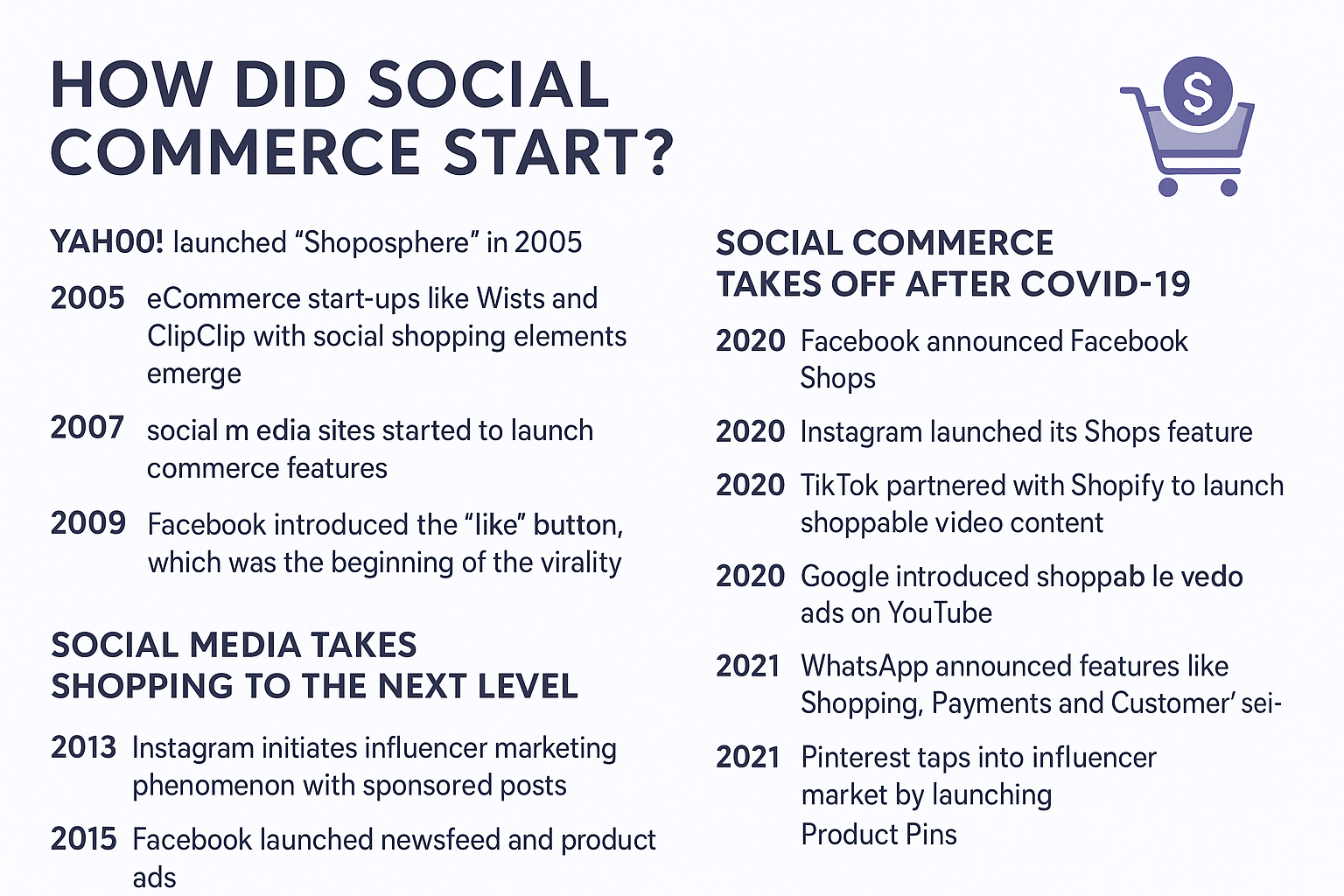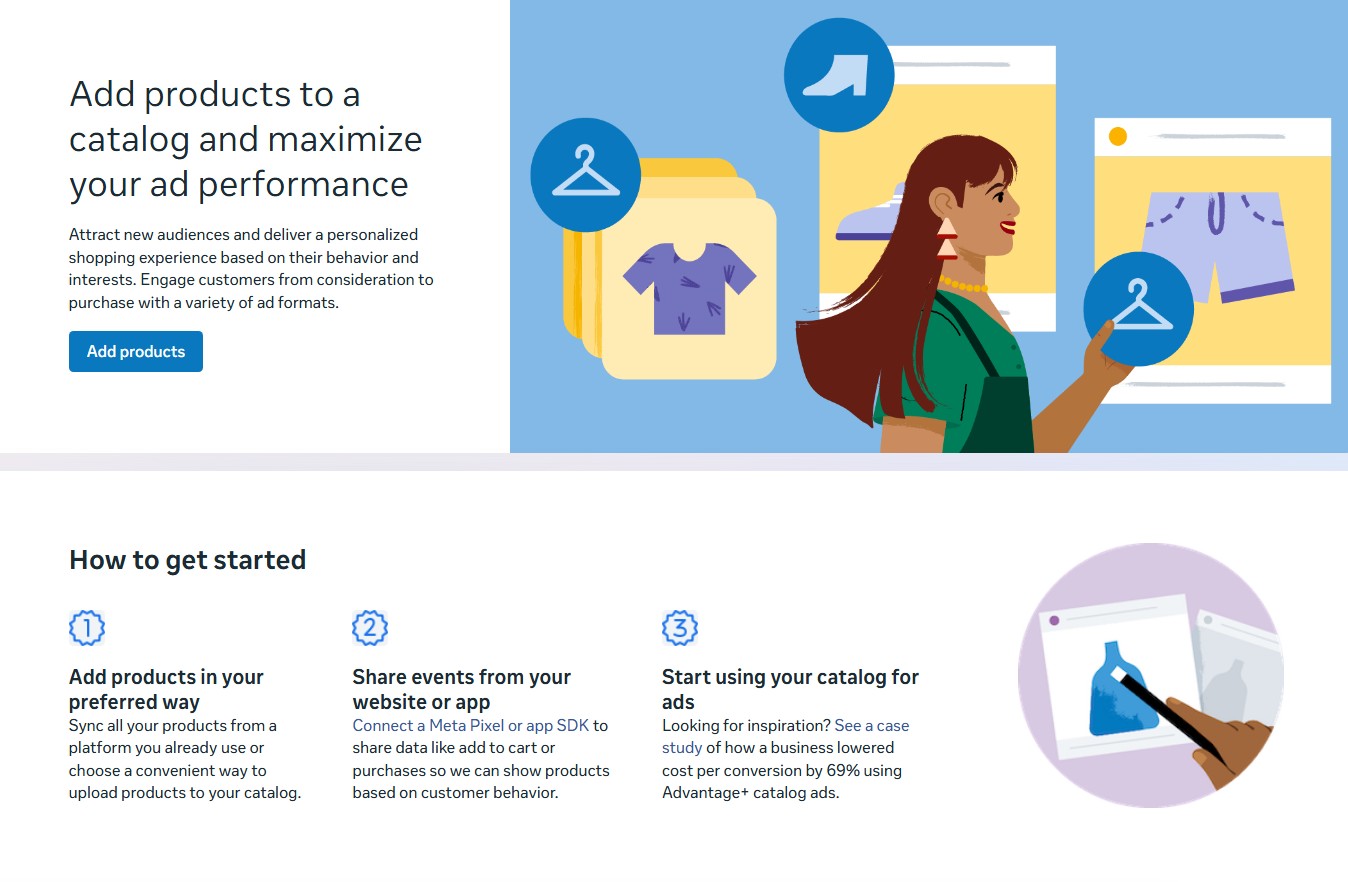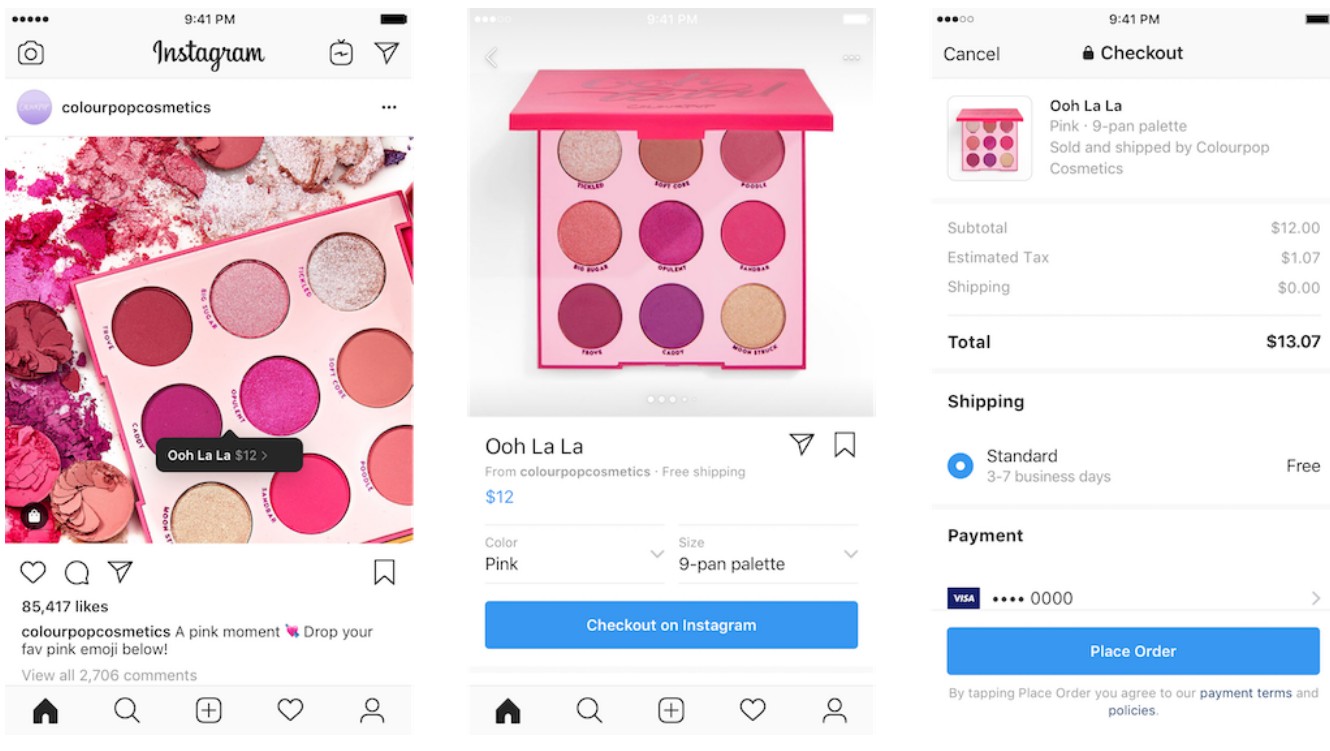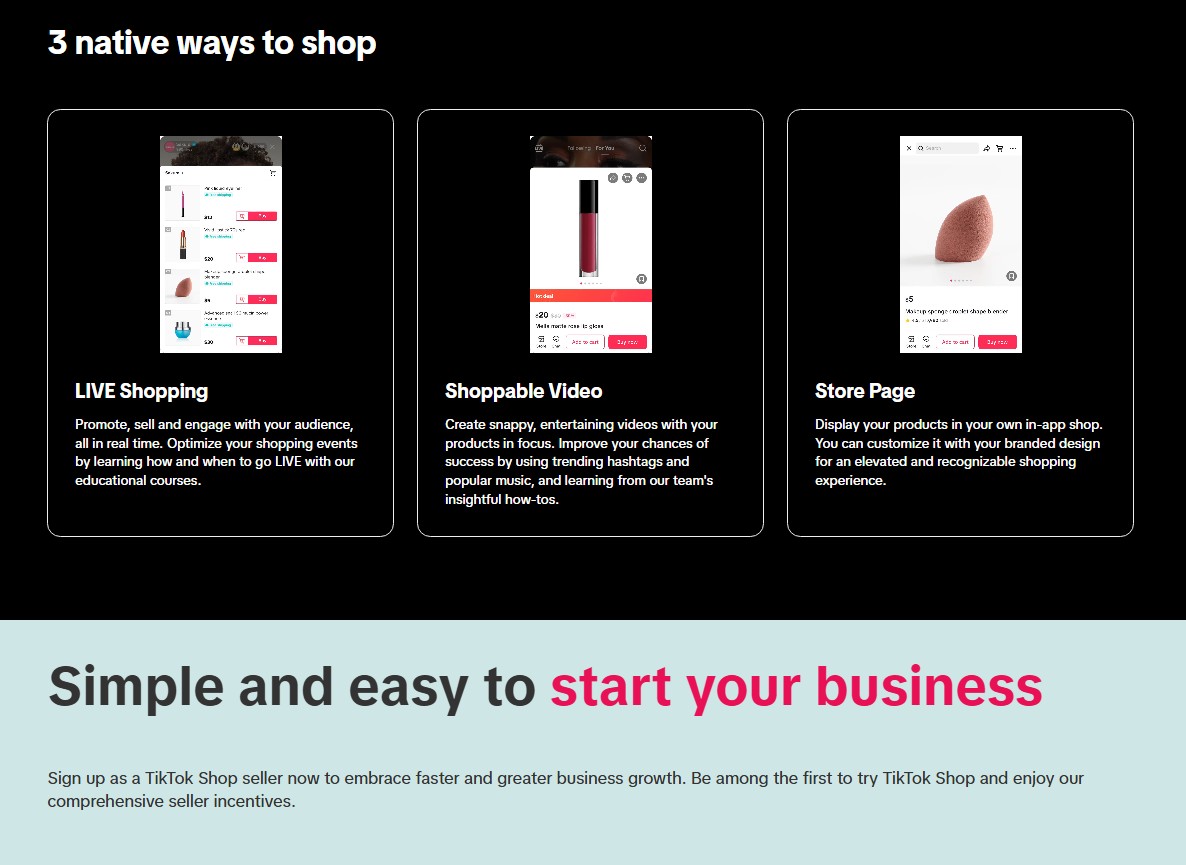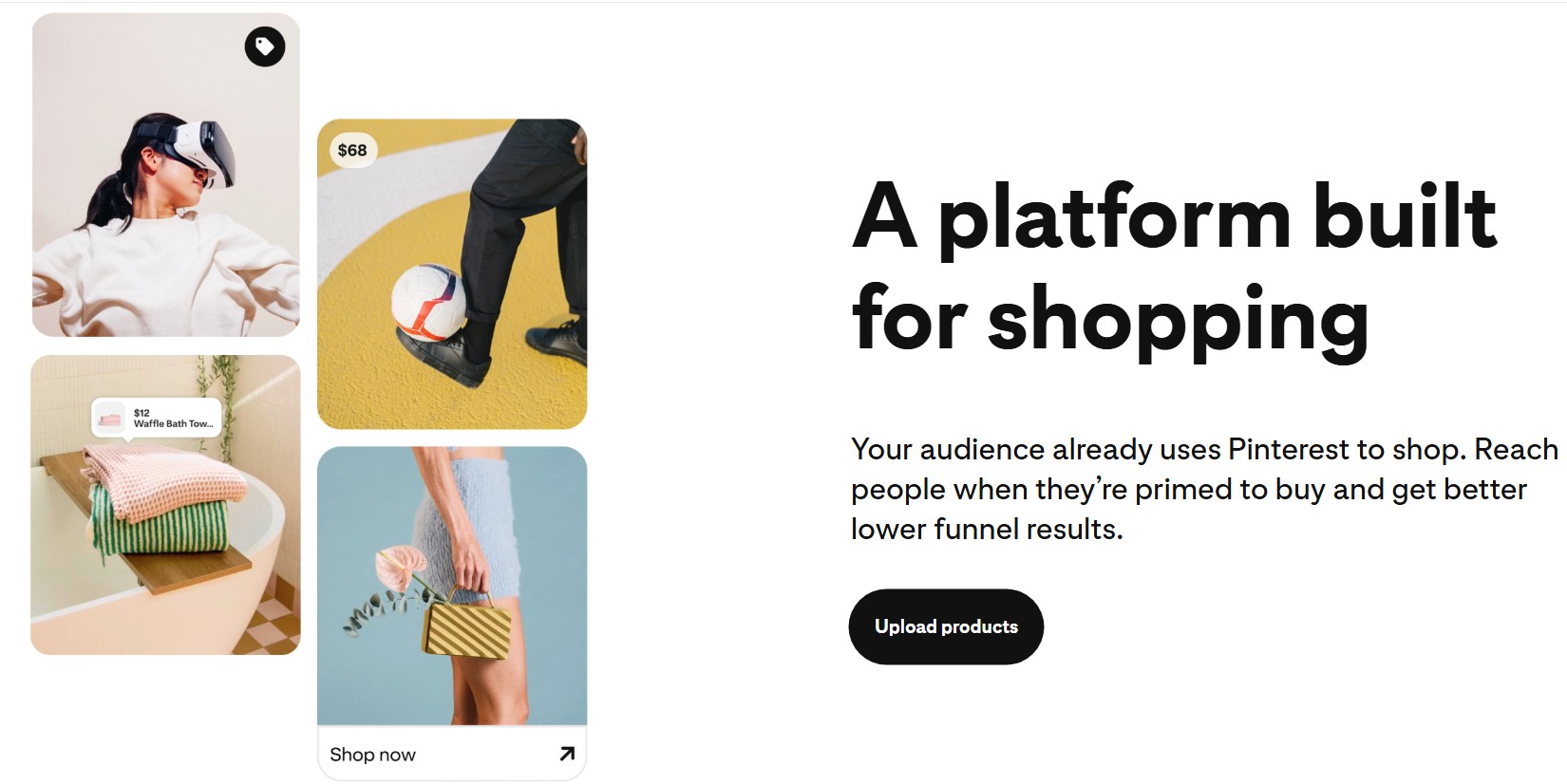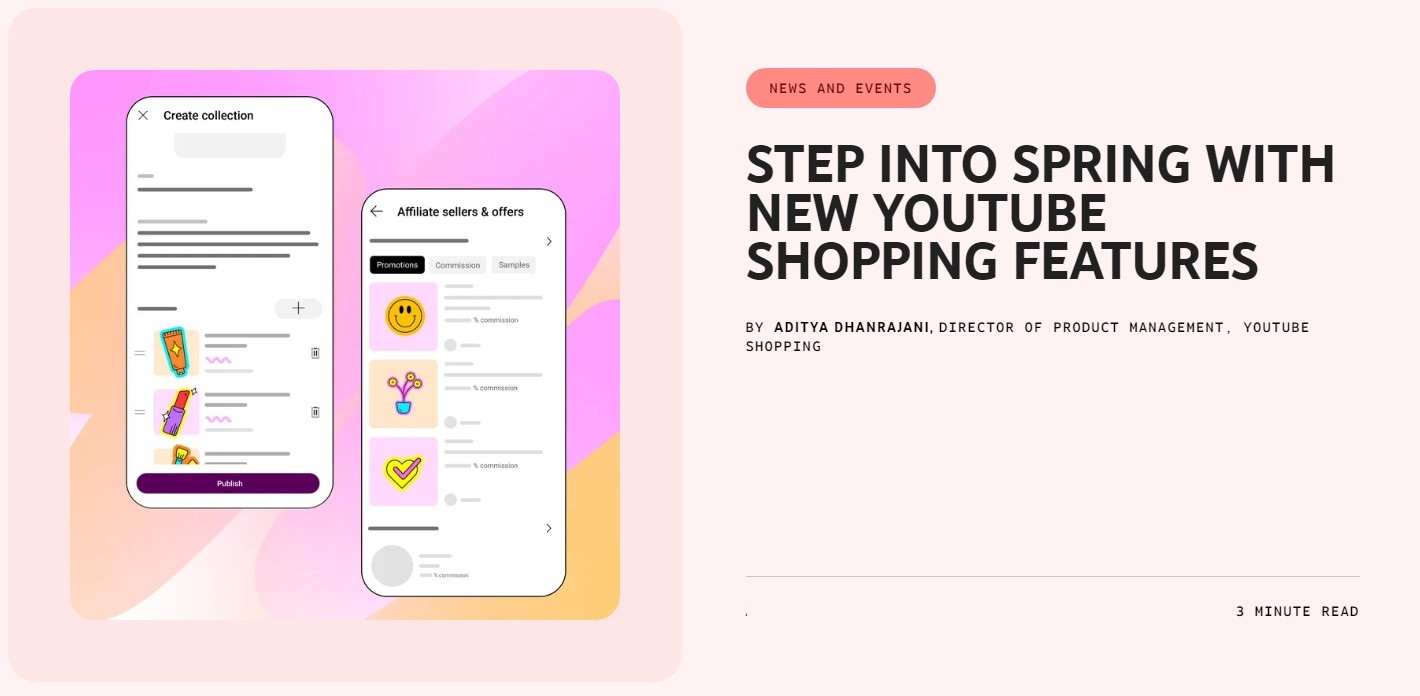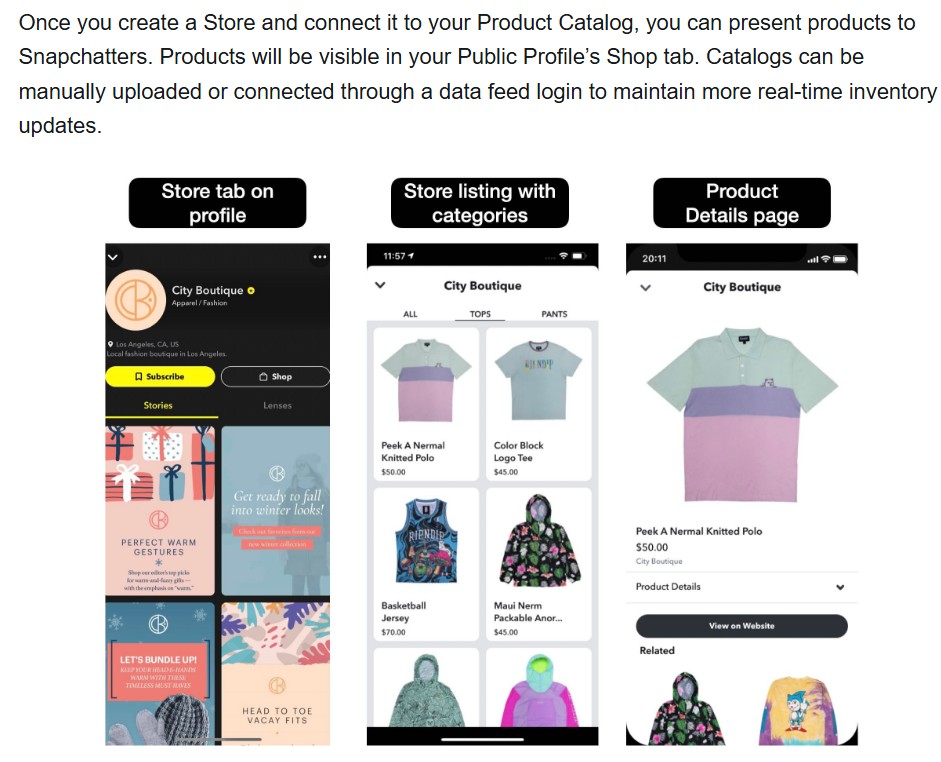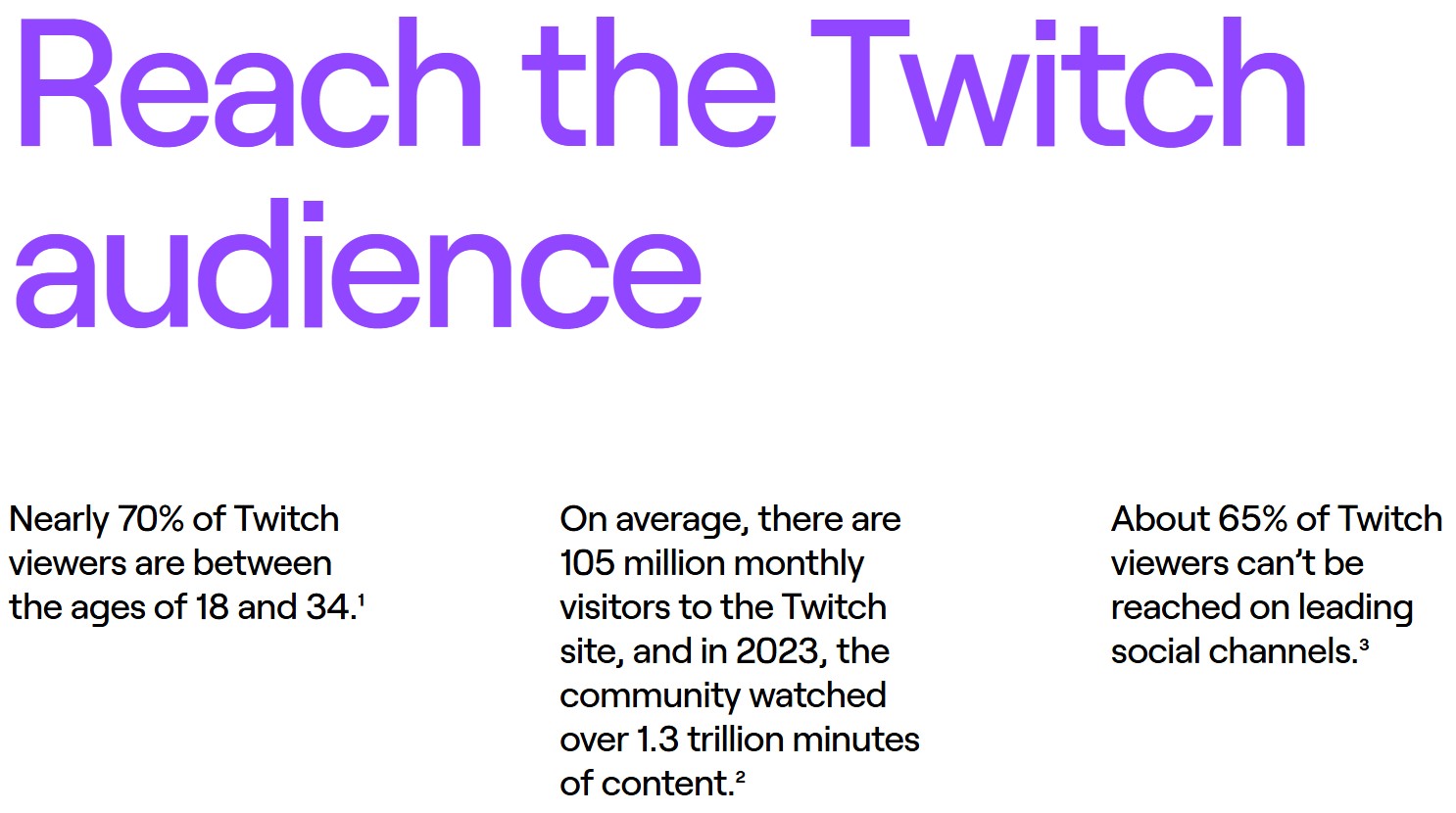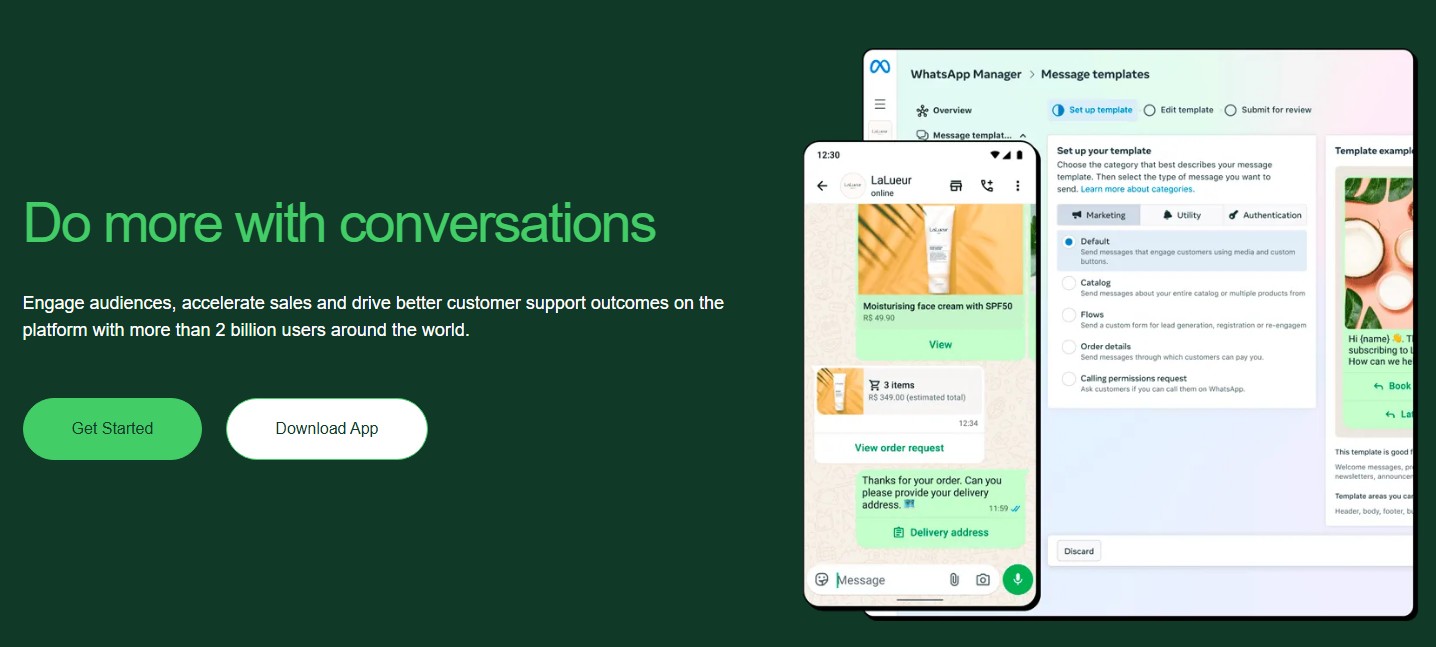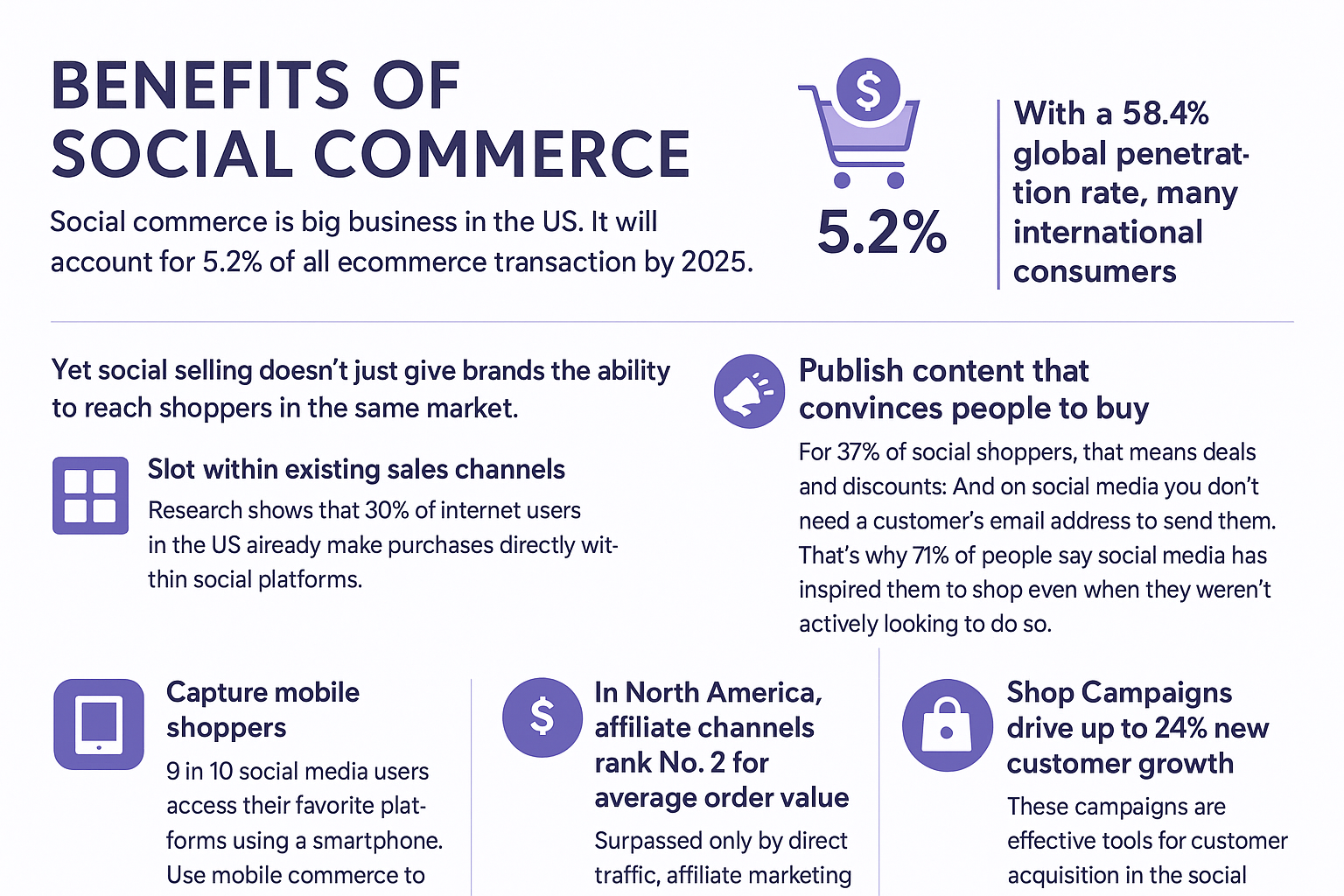Social Commerce Has Reshaped Online Retail
Written and edited by: Jay
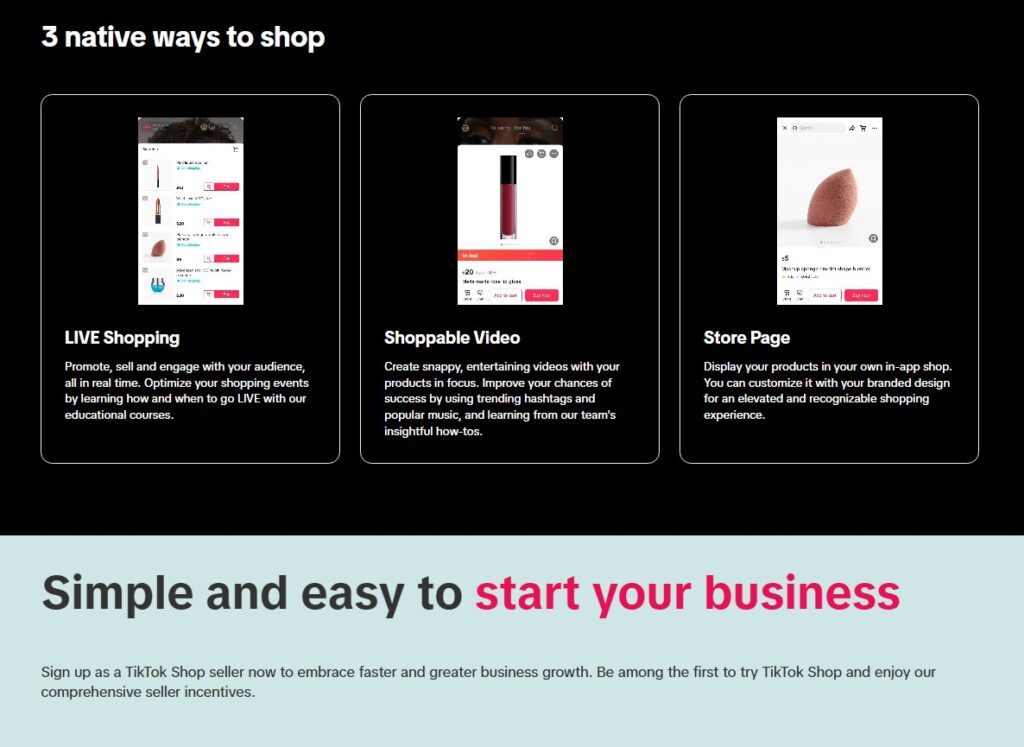
Jay Myers here, and I want to start this one with a confession that might surprise some of you. I’ve never, as in not even for one moment, thought social commerce was hype or just another buzzword that YouTube’s e-commerce “gurus” were throwing around as click bait. It’s not that I’m developing a sideline as a fortune teller. It’s more that. Well. If you’re a retailer, the primary virtue of “online” is the ability to effectively pick up your store and put it down in front of your potential customers. So if your customers are on TikTok choreographing coordinated dances to Forrest Frank, you have an online store, specially because it’s possible to pick it up and just meet them over there.
Now, I am not 100% certain that my powers of prescience would have driven me to describe social commerce as having “fundamentally reshaped how consumers discover, evaluate, and purchase products online” five years ago. But here we are not just talking about posting product links on Facebook anymore. We’re talking about fully integrated shopping experiences that live inside the social channels where your customers are already spending hours every day. Forrester Research, found that 2025’s social commerce sales in the United States alone are projected to double 2023’s sales and reach $107 BILLION, representing a compound annual growth rate of 24.9% from 2020.
Of course. The story isn’t the growing size and reach of social marketplaces. It’s how several dramatically different social ecosystems have engendered entirely different shopping behaviors, customer expectations, and thereby created new opportunities for merchants. If you’re a Shopify retailer who’s still only treating social media engagement as a traffic driver to your store, you’ve missed the trend in its entirety.
But. If you haven’t missed it and you’re just overwhelmed by the sheer number of platforms claiming they can help you sell what you sell, you’re why I put this “guide” together. This isn’t going to be another superficial overview of social commerce features. We’re going deep into the strategic implications of each major network, which types of Shopify brands will benefit most from each audience, and how to think about social commerce as part of your broader e-commerce strategy rather than some social media experiment set off to the side.
The Psychology Behind Social Commerce Success
Before we dive into the specifics of each social marketplace in turn though. Let’s spend a minute or two or three talking about why social commerce doesn’t work or convert in the same way that traditional e-commerce does. Because understanding the behavioral psychology will help you make better decisions about which channels are best suited to your brand and the time and investment success will require.
Until all this broke out, online shopping followed a pretty predictable pattern. A consumer would have a need, they’d search for a solution, compare their options, and make a purchasing decision. It was rational, research-driven and intentional. Well. Social commerce has flipped that process on its head. Research from the Wharton School found that most social purchases are “discovery-driven impulse buying.” Or in other words. Social consumers aren’t looking for products when they buy them. They’re looking for entertainment, connection, inspiration, information and the products have just become a part of that. Their purchases are secondary to the experiences they’re chasing via social media.
So social is an opportunity and a significant challenge for Shopify merchants. On the opportunity side, retailers can reach customers who’d never find or even think look for them through traditional search. For whom products become part of cultural content experiences they’ve actively sought out and engaged with. Of course on the challenge side, you have competing for their attention in environments where they aren’t in “shopping mode.” Where offerings have to be compelling enough to interrupt someone’s browsing and inspire impromptu buying.
The social channels best suited to doubling as online marketplaces are those that’ve made those interruptions feel like they are natural parts of their experience, rather than unsubtle intrusions. That have integrated shopping seamlessly, so social buying feels like a logical extension of engaging with the content they’re there for. Now, let’s put the “boring” behavioral psychology behind us and examine how each social marketplace approaches integrating e-commerce and which kinds of retail brands each one’s audience is best suited to.
Facebook Shops and Facebook Marketplace
Technically, Social Commerce has been a thing ever since Yahoo launched “shoposphere” back in 2005 with Pick List. But the ecosystem as we know it, really got its start in the early 2020s during Covid when Google introduced Shoppable Video Ads and Pinterest launched Product Pins and Facebook Shops launched. And one thing I’ve learned watching Shopify merchants succeed or fail with Facebook Shops is that when it works, it works because Facebook Ads arguably have unmatched audience targeting capabilities, not because of the shopping experience itself.
Even in relative decline, Facebook still attracts over 2.9 billion active users monthly, which means you’ll probably be able to find your consumers there regardless of how niche your products are. Plus. Whatever else you can say about Meta, Meta’s advertising platform remains social media’s best. So. Merchants can custom target potential customers based on interests, behaviors, and demographics.
That said, like other social marketplaces, Facebook Shops will only work for specific types of Shopify merchants. So, please don’t be one of those retailers who tries to force it to fit when they’d be better served chasing their consumers over on Twitch or WhatsApp Business.
Facebook Shops Works Best For:
-
-
-
- Brands selling products that benefit from detailed descriptions and multiple images
- Stores with higher-priced items where customers expect to research before buying
- Merchants with established email lists looking to create lookalike social audiences
- Shopify merchants who already have successful Facebook advertising campaigns
- Retailers targeting demographics (i.e. older than other platforms) that are still active on Facebook
-
-
Facebook Shops Struggles With:
-
-
-
- Products that require trend-based or viral marketing approaches
- Impulse purchase products best sold with visual demonstrations
- Brands trying to reach demos younger than Gen-X
- Merchants without advertising budgets (organic reach on Facebook is a dead parrot)
-
-
The key thing to remember about selling on Facebook Shops is that it won’t really be about the social shopping experience. It’ll be about leveraging Facebook’s advertising ecosystem to drive targeted traffic through its streamlined sales process. So. Think of this as advanced social media advertising that just happens to include a cool checkout functionality, not as social commerce in the truest sense of the term.
So. If you plan to succeed selling on Facebook Shops, you’ll need to approach the marketplace as social media marketing that reduces checkout friction not as an engine of social discovery like its sister service Instagram.
Instagram Shopping
By contrast, Instagram Shopping represents what it would be fair to describe as an archetypal social marketplace. It’s where consumers go to discover the lifestyle they want to buy into, emphasis on BUY. It’s where influencer culture began and is broadly popular, reaching over 2 BILLION users monthly, earning particularly strong engagement among demographics with more than their fair share of purchasing power. But more importantly, Instagram users come to the platform expecting to discover products. So they’re primed to purchase there in ways they simply wouldn’t be on Facebook.
Instagram’s visual focus means that products need to photograph well and tell a story through imagery. But Instagram Shopping isn’t just about posting pretty product photography and hoping for the best. Success on Instagram Shopping comes from understanding that you aren’t selling products. You’re selling consumers entry into the lifestyle or community your products represent.
Instagram Shopping Works Best For:
-
-
-
- Retailers who can “authentically” partner with social influencers
- Fashion, beauty, home decor and other lifestyle brands
- Obviously. Products that photograph exceptionally well
- Brands who can create consistent visual narratives
- Merchants with Millennial or Gen Z target demographics
- Shopify Stores selling products their customers tend to show off or share
-
-
Instagram Shopping Struggles With:
-
-
-
- Brands without a strong visual identity or aesthetic coherence
- Again. Obviously. B2B products or services
- Items that require detailed technical explanations
- Products with complex sizing or customization needs can be tricky
- Merchants who can’t consistently produce, high-quality visual content
-
-
The secret to Instagram Shopping won’t be pulchritudinous product photography, though good shots will certainly help. It’ll be creating content that makes your products feel essential to the lifestyle your audience aspires to via Instagram. If consumers can envision how your brand fits into their Instagram idealized image of themselves, the platform will be an indispensable sales tool.
But if your products don’t naturally fit into lifestyle content or if you can’t consistently create visually compelling content, your time on Instagram Shopping will feel like pushing a rope uphill.
TikTok Shop 
We’re all friends here so I’m just going to be blunt and honest on this one. TikTok Shop is either going to be a truly transformative expansion of your Shopify store’s reach or a complete waste of your good gosh darn time. Few merchants will fall into the minimal middle ground, and the difference will just come down to how well suited your products are to demonstration commerce.
TikTok Shop works because it integrates purchasing directly into the entertainment experience. Customers discover products through videos that demonstrate, explain, or showcase them in action. The key word there is ACTION. Because static product showcases rarely sell on TikTok Shop. Products that can be demonstrated or displayed in compelling ways, on the other hand, dominate.
TikTok attracts 1 BILLION+ users monthly, with particularly strong engagement among Zoomers and Zillennials. But the real opportunity isn’t the audience size. It’s the algorithm’s ability to make niche products go viral with audiences that have never heard of your brand. TikTok Shop can turn completely unknown products into must-have items literally overnight. Not through paid advertising, but through viral content that demonstrated a product’s value in an entertaining way.
TikTok Shop Works Best For:
-
-
-
- Products that can be demonstrated in 15-60 second videos
- Items that solve obvious problems in fun or funny ways
- Trend-based or seasonal products
- Products with strong visual or functional “wow” factors
- Beauty, kitchen gadgets, organizational tools or pet products
- Products suited to being sold as a “life hack” or as part of a lifestyle transformation
-
-
TikTok Shop Struggles With:
-
-
-
- Brands without the resources to adapt quickly to trends or algorithm changes
- High-consideration products that typically require pre purchase research
- Products that just don’t photograph particularly well
- B2B brands, services or digital products
- Shopify Merchants who’re uncomfortable using user-generated content strategies
-
-
Unfortunately or fortunately, depending on your personal point of view, TikTok Shop success probably won’t depend on “your” product content. Instead. It’ll depend on the content Tiktokers create about your products. You see, the platform’s algorithm is infamous for its ability to sniff out and reward authentic user-generated content over polished brand content, which means your strategy there should focus on making your products “shareable” rather than just “buyable.”
The brands that thrive on TikTok Shop do so by inspiring influencers and just ordinary everyday users to create “demonstrations” that introduce products to the platform’s audiences organically.
So. If your product content can engage and encourage user-generated demonstration content, selling on TikTok Shop could absolutely transform your business. If it can’t, you’ll struggle to gain traction no matter how much effort you invest. Actually, let me put that super bluntly. If someone wouldn’t naturally want to film themselves using your product TikTok Shop probably isn’t for you.
Pinterest Shopping
Pinterest Shopping is probably the single most underestimated social commerce platform I’m covering, and I think it’s because most merchants fundamentally misunderstand what Pinterest users are trying to accomplish. Pinterest isn’t social media in the traditional sense. It’s a visual search engine where people go to discover solutions to future problems or inspiration for future projects. Even years past its peak, Pinterest is still attracting over 578 MILLION pinners monthly. Users who’re actively searching for products and ideas rather than passively consuming content
Which represents an ideal dynamic for e-commerce. Pinterest users aren’t in entertainment mode, they’re in research mode. They’re planning purchases, not making impulse decisions. They’re searching for products to solve specific aesthetic problems or fit lifestyle specific criteria.
Pinterest Shopping Works Best For:
-
-
-
- Craft supplies and creative project materials
- Home improvement and DIY products
- Wedding, party, and event planning items
- Seasonal and holiday merchandise
- Home decor and interior design products
- Food products, kitchen tools and appliances
- Fashion items that fit specific style categories
-
-
Pinterest Shopping Struggles With:
-
-
-
- Brands targeting demographics that don’t use Pinterest for planning
- Time-sensitive or trend dependent products
- Impulse purchase items
- Products that don’t fit clear categorical searches
- Shopify Merchants who can’t create consistent, searchable visual content
-
-
The main thing to understand about what it’ll take to succeed within Pinterest Shopping is that pinning consumers are building collections for future reference… To furnish the apartment they’ll be moving into, to wear on a trip they’ll be taking, not just browsing for immediate entertainment. Pinterest Shopping will be the best fit for retailers ready to think of it as visual SEO rather than as any kind of social media marketing. Seriously. Consumers search Pinterest like they search Google, only using images instead of text. So if whatever you’re selling can be found through visual searches and further solve the kind of lifestyle problems pinners plan for, you can do well.
YouTube Shopping
Hope it’s not too jarring to jump from a social network that’s still attracting plenty of targetable consumers, but is still admittedly in decline to one I honestly think might be the future of social commerce, but that’s where we are. YouTube Shopping will require a different content strategy than any other platform. YouTube users come to the platform to learn and be entertained by content ranging from minute long short-shorts to hours long deep dives. It reaches over 2.7 BILLION viewers monthly. Which makes it the second-largest search engine, after Google itself.
Success there will depend on creating content that attracts, genuinely engages viewers, and provides genuine value independent of the e-commerce component. Users need to benefit from watching your videos even if they never buy anything. The commerce integration works when purchasing becomes a natural extension of the educational or entertainment value you provide.
YouTube Shopping Works Best For:
-
-
-
- Products that benefit from detailed explanations or demonstrations
- Complex products that require customer education
- How-to, tutorial, and instructional content
- Product reviews and comparison content
- Brand storytelling and behind-the-scenes content
- Educational content for product categories and use narratives for specific products
-
-
YouTube Shopping Struggles With:
-
-
-
- Requires significant time investment in content creation
- Takes longer to generate results than other platforms
- Needs consistent, high-quality video production
- Requires expertise in video SEO and YouTube algorithm optimization
- Not the place for Shopify merchants unwilling or unable to commit to content creation
-
-
What you’re going to find here is honestly what you already know about YouTube. It’s huge. It has a huge audience. And lots of different things in lots of different shapes and sizes from lots of different channels work from comparatively to very well. It’s kind of a bigger mirror image of Pinterest in that to get the most out of it, you’ll need to approach building a YouTube store as content marketing that just happens to include an e-commerce checkout. That said, successful YouTube Shopping channels have the feel of natural-helpful branding rather than “commercials.”
Snapchat Shopping
If it feels like Snapchat Shopping is one of those things that should have been a thing since at least 2018 it’s because it was. Their first foray into e-commerce, Snap Store, rolled out back in 2018, and it was followed by a bitmoji shopping feature in 2019, but like the other commerce channels the marketplace features of interest to Shopify Merchants were introduced between 2021 and last April. Today. Even a decade past its prime. Snapchat reaches over 932 MILLION users monthly, and attracts particularly strong engagement among younger demographics, but their social commerce features are arguably a bit under-developed compared to other platforms.
Snapchat’s let’s call it … ephemeral approach to content presentation makes it a natural venue for limited-time offers, exclusive releases and scarcity-driven marketing. But also makes building and sustaining the consumer relationships that other social channels revolve around challenging.
Snapchat Shopping Works Best For:
-
-
-
- Limited edition or exclusive product launches
- Time-sensitive promotions and flash sales
- Brands with strong Gen Z followings
- Event-based or seasonal merchandise
- Products that benefit from augmented reality try-on experiences
-
-
Snapchat Shopping Struggles With:
-
-
-
- Less mature commerce infrastructure than other platforms
- Smaller overall user base compared to major platforms
- Ephemeral content makes it difficult to create lasting shopping experiences
- Limited targeting and advertising capabilities compared to Facebook or Instagram
-
-
Given its content demands, unless you have a specific strategic reason to be on Snapchat or you’re targeting the difficult to target demos particularly active there, I’m not sure I’d recommend the investment.
Twitch Commerce
If YouTube Shopping equals the “future of social commerce” Twitch Commerce either equals the next Snap Shop or the evolution that’s destined to follow YouTube’s evolution. Either way, it’s an interesting but challenging social commerce opportunity for authenticity-centric Shopify brands looking for a way into gaming streaming culture. Twitch averages over 26 MILLION viewers a day! Who spend hours watching their favorite streamers play games, reacting to that content, or just chatting in massive gaming communities. The platform’s live, interactive focus is a unique opportunity for brands selling into tight lifestyle communities or by using product demonstrations.
Of course there’s a catch. And it’s that retailers can’t just advertise gaming products to gamers and expect to succeed there. Twitch users are not unlike Ready Player One’s Gunters in that they’re notorious for discriminating against “inauthentic” brands. They can spot forced product placements from millions of miles away, and they’ll call them out in chat immediately. Success on Twitch commerce hinges on offering genuinely useful products to the streamers and their communities.
Twitch Commerce Works Best For:
-
-
-
- Products that can be authentically demonstrated during live streams
- Gaming accessories, equipment, and software
- Tech products that enhance streaming setups
- Home office and comfort products for long gaming sessions
- Food and beverage products that streamers actually use during streams
-
-
Twitch Commerce Struggles With:
-
-
-
- Requires deep understanding of gaming and streaming culture
- Users are highly skeptical of inauthentic brand integrations
- Smaller overall market compared to other platforms
- Requires building relationships with individual streamers rather than broad advertising
- Success will often depend on organic community adoption rather than paid promotions
-
-
On Twitch it’s not going to be about the platform’s e-commerce features. It’s about whether your brand can integrate into streaming culture and content authentically. If you’re selling products streamers would naturally use and recommend to their audiences, Twitch can be a powerful sales channel. And that’s becoming truer over time. Like the platform has been quietly testing integration features that will let viewers purchase products the streamers use during broadcasts.
WhatsApp Business
The WhatsApp approach to social commerce is more about personalized communication than some Shopify Brands will be prepared for in the context of social media. I mean. WhatsApp has over 2 BILLION users and is the most widely used messaging platform globally. But WhatsApp Business isn’t built around broadcasting to that large audience. It’s about almost individualized shopping experiences and one-to-one, or at most small group brand marketing communications.
So if you have a high-touch, consultative, approach to selling whatever you sell, you are in luck.
WhatsApp Business Works Best For:
-
-
-
- Brands capable of providing expert guidance and personalized recommendations
- High-value, consultative sales processes
- Custom or personalized products
- Services that require scheduling or coordination
- Local or regional businesses serving specific geographic areas
- International consumer audiences for whom WhatsApp is the dominant social platform
-
-
WhatsApp Business Struggles With:
-
-
-
- Limited automation capabilities compared to other platforms
- Not really suited for mass-market, low-touch product brands
- Doesn’t really scale easily to large audiences
- Will require customer service resources some merchants may be reluctant to commit
-
-
Just as with some of the social channels we’ve already covered, the trick with WhatsApp will be learning to treat it like one thing that’s really another thing. In its case like a premium customer service channel that coincidentally includes e-commerce functionality. You see, the consumers reaching out to your brand within WhatsApp, will expect expert personal attention and guidance.
Making Smart-Strategic Choices About Platform Selection
Now. I can practically hear some of you thinking, “This was all great and all Jay, but how am I supposed to be active on EIGHT different social commerce platforms?” That’s exactly the wrong way to approach this for two reasons. First, because we’re discussing opting into a consumer audience, recent research indicates includes 63% of Gen X, 73% of Gen Z and 82% of Millennials. And second, because the merchants who succeed with social commerce are those who choose one or two platforms that align with their products, audience, and operational capabilities, then execute exceptionally well on those platforms, rather than by spreading themselves thin across all of them.
Here’s some advice for making smart platform selection decisions …
Start with your current customer demographics. Where are they most likely spending their time online? How have they discovered and researched your products? What types of product content is already attracting them and encouraging active engagement?
Consider your product characteristics. Do your products photograph well? Can they be demonstrated quickly? Do they fit into a narrative friendly lifestyle? Do they require detailed explanations? Are they being purchased by impulse buyers or careful planners?
Honestly audit your operational capabilities. How much time can you realistically invest in custom targeted content creation? Do you have video production capabilities? Do you have a customer service staff set up to respond to consumer inquiries quickly?
Brutally evaluate your competitive landscape. Which social commerce platforms are your competitors on and seem to be using successfully? Are there opportunities to differentiate by focusing on underutilized platforms where your products could stand out?
Consider your long-term strategic goals. What would you actually be attempting to accomplish by throwing your hat into the social commerce ring? Reach new audiences? Increase average order value? Reduce your customer acquisition costs? Build brand awareness? Some of the answers will be good reasons to make the leap, others less so.
The biggest mistake merchants make here is deciding to do social then deciding to treat social commerce like any other advertising channel. Unless your brand is unusually well-aligned with the diverse-dissimilar audiences frequenting Twitch and Pinterest respectively, pushing your existing product marketing messaging onto those platforms without adapting to how they actually work isn’t going to work.
You’ll need to integrate your tech stack and your approach to messaging and customer service to each platform’s unique culture, content formats, and user expectations. The same product will need completely different strategies on Snapchat versus Instagram versus TikTok.
Connecting Social Commerce to Your Shopify Store
Each social commerce platform fosters different types of customer relationships and shopping behaviors. Instagram Shopping shoppers might expect ongoing lifestyle content and visual inspiration. Customers on TikTok Shop might be more price-sensitive and focused on product functionality. Your audience on Pinterest might be planning purchases for weeks or even months
This might mean creating different email sequences for customers acquired through different social platforms, developing platform-specific content for customers who follow you on multiple channels, or adapting your customer service approach based on how customers initially engaged with your brand. Don’t get me wrong. The goal isn’t to treat each social platform as a separate business, but to use social commerce as different entry points into a comprehensive consumer relationship ultimately centered on your Shopify store, and broader brand experience.
Looking Forward to the Future of Social Commerce
It’s a cliche to say that the social commerce ecosystem is evolving rapidly, but it’s also just true that the social commerce ecosystem is evolving rapidly and the platforms that dominate it today might not matter much in two, three or four years. It might not even be that long. By the next Shopify Summit we all may have moved onto Japan’s LINE Shopping, the 1.3 BILLION Chinese consumers circling WeChat Stores each month or the growth of Little Red Book (Xiaohongshu).
So, it’ll be the underlying principles that we’ve discussed, understanding and adapting to social consumer behavior, creating valuable authentic content, and integrating commerce into each social platform naturally, that will remain relevant regardless of what changes the future brings.
Focus on creating genuine value for customers within each platform’s unique context rather than trying to force their existing marketing approaches onto new channels. And they’ll integrate social commerce activities into comprehensive customer experience strategies rather than treating them as separate, disconnected sales channels. The opportunity is enormous, but so is the level of difficulty.
Getting a Professional Helping Hand If You Need It
Look, everything I’ve covered in this guide represents hours of strategic thinking, platform testing, and operational optimization. And honestly, it was all just where you start. Things only really get complicated when you actually start integrating social commerce strategies with your existing Shopify operation, managing inventory across multiple marketplaces, coordinating content creation across different channels with different audience demographics, and optimizing consumer experiences for different acquisition sources.
Many Shopify Retailers don’t have the internal resources to execute elaborate social commerce strategies while staying on top of their core businesses. That’s not a criticism. It’s just the reality. So. Getting social commerce right may require specialized expertise, dedicated talent, and operational systems that many merchants would need outside help to develop then implement.
Whether you’re in need of strategic guidance, support for content creation efforts or community management, technical help integrating, or a comprehensive social strategy developed, the key will be finding partners who understand both the social media landscape and e-commerce operations. That’s the kind of challenge that Bold Match was designed to solve. We connect Shopify merchants with vetted agencies that specialize in social commerce integration, helping you find the right expertise for your specific needs without having to navigate the overwhelming landscape of service providers on your own.
Well, that’s it for me for today. I hope you’re finding tons of value in the resources we’re building. My co-founder Eric Boisjoli will be publishing a detailed technical guide covering the nuts and bolts of integrating social commerce platforms with your Shopify store. He’ll walk through API integrations, inventory management across multiple platforms, automated workflow setup, and the technical implementation details that turn a social commerce strategy into operational reality. Until then, keep building something awesome, and remember that Eric and I built Match to Help Retailers find the expertise they need to grow beyond what you can handle internally. – Jay
